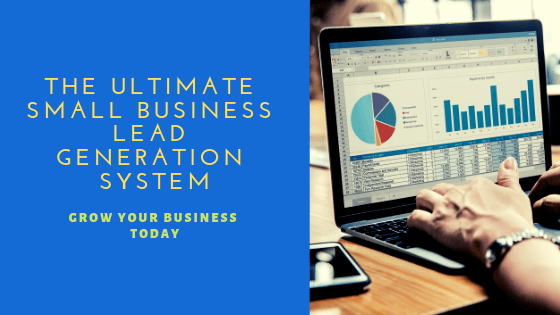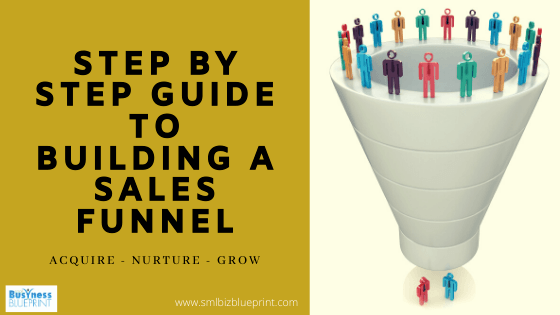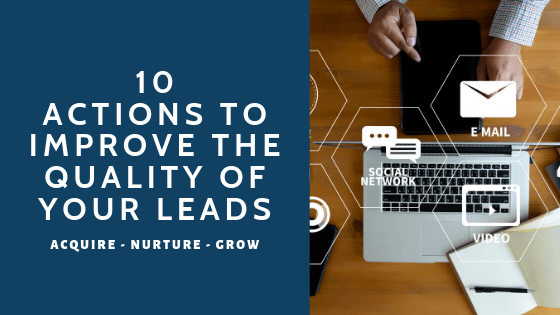The business lead generation system is a two-part system based on:
Direct response advertisements that offer attention-getting special reports
and
A contact management system for follow-up

This simple to implement, proven and effective system should be the keystone in your marketing efforts and if carefully followed will produce a continuous and never-ending stream of new prospects for your business
If you are a typical business owner, manager or salesperson you are most likely spending a lot more money in gaining new customers than you need to, money you don’t have to spend, money that could be used to grow your business even faster, or money that could go straight to the bottom line of your balance sheet and into your bank account to be used as you wish.
But it doesn’t have to be that way. There are better more effective marketing efforts than what most people are using.
Here is a simple little test that can give you an idea of how you’re doing
Ask yourself the following questions:
What marketing methods are you currently using to acquire new clients?
How do they differ from what you used when you first started in business?
How do they differ from what was used by people in your business or profession 20 years ago?
Do your advertising or direct mail campaigns produce a sizeable profit for you every time you run them?
Do you have an ongoing marketing system in place that produces consistent measurable and predictable results month after month after month?
What kind of response rates are you getting from your marketing efforts?
Are you satisfied with those response rates?
The fact is most business owners and salespeople are still attempting to market their products and services the same way there have always doneand that every other business like theirs is currently doing.
What most business owners do is the same thing they have done year after year after year and they expect a different result.
Now here’s an interesting consideration: if you do what everyone else in your marketplace is doing what makes you think for a minute that you can get any better results than their getting?
You can’t. It’s impossible.
What are you doing that separates you from everyone else in your market?
Are you doing something different from everyone else? Are you standing out?
In today’s ever-busy world consumers, customers, prospects are bombarded with thousands and thousands of messages.
How do you plan to set yourself apart from all this noise and to show that your business is different from what everyone else is advertising?
If you really want your business to be successful you must step out of the box and look at the way other businesses in other industries market themselves and operate their enterprises.
By adopting certain strategies then adapting them to your business you can take your business light years ahead of your competition and literally leave them in the dust.
The best marketer wins every time
What really matters what really counts what really makes a difference is how you market your business. That’s it.
How you let others know the benefits and advantages gained from doing business with you as well as what they will lose if they don’t do business with you.
The plain simple fact is marketing is the most important activity in your business by far.
Everything else in your business can be the greatest. You can have the greatest products, the lowest prices, a wonderful reputation, good name recognition, the best customer service, but if you don’t have anyone to sell to what good are these things?
On the other hand, if you don’t rate number one in all those categories if you have a steady stream of qualified prospects seeking you out, wanting to know more about how you operate and nearly standing in line to do business with you it’s nearly impossible for you to fail.
If you are to list everything you could think of that could contribute to the success of your business then rank them in order of importance the number one item on your list would have to be:
How to cost-effectively get a consistent and never-ending stream of qualified prospects wanting to do business with you on your terms then keeping them for as long as they need the products services you offer.
Question
Who do you want to do business with?
Answer
Qualified prospects.
You don’t want to waste your time with the prospect you can’t sell to. You’re not in this business for the practice.
Your time is valuable.
Attracting and dealing with qualified prospects only will increase your efficiency and profitability.
Next, you must get a consistent and never-ending stream of these prospects. For sure you don’t want your source to dry up. You want to be out to turn on your system any time you need additional business and then turn it off or turn it down when you get too busy.
But merely attracting a bunch of prospects isn’t enough. You’ve got to do it cost-effectively.
If you spend more on acquisition costs than you’re making profits or commissions you end up with a losing proposition.
Too many business owners and salespeople bend over backwards trying to be all things to all people. They figure that if a person can afford them and have the money to pay for the product or service they are selling that person is worth having as a customer.
But that’s not always true not by a long shot.
There’s a big difference between being eligible and being desirable. Just because a prospect does qualify (eligible) and has the ability to pay doesn’t mean that they will make desirable customers.
Some people can be more trouble than they’re worth and can cause frustration stress and discord among you and your staff.
You want clients who work within the parameters you set not what they were used to (or demand from you) with some other business owner, salesperson or company.
Finally, you want to hang on to those customers for as long as they need the products or services you sell.
People’s lives change. Sometimes a need for certain types of products increase and another time they change their lives and eliminate the need for certain products.
But as long as they have a particular need you want to keep them doing business with you and not seeking out one of your competitors.
As a small or medium business with a limited amount of money to spend and an urgent need for your business to make profits you can’t afford to take on the task branding like the corporate giants do.
So if you’re ready to begin turning your business career into a powerful customer magnet let’s get started.
Advertising image versus direct response There are two types of advertising design strategies: image advertising and direct response advertising.
Image advertising is meant to remind consumers of your brand and the products and services you offer.
If you’ve seen Coke or Nike commercials you have seen image advertisements. Some 95% of all advertising you see on television and in print is image advertising.
Direct response advertising, on the other hand, is meant to evoke an immediate response and compel your prospects to take some specific action.
Such as picking up the phone calling for more information or to place an order.
Most infomercials are good examples of direct response advertisements.
What makes a direct response ad?
Direct response ads have several distinguishable characteristics that make them unique compared to image ads.
First, they are trackable.
That is when someone contacts you for information or to place an order you are able to determine exactly which ad in which media they responded to.
Second, they are measurable.
Since you know which ads are being responded to and how many contacts you receive from each one you can measure which ads are the most effective and which ads need to be changed or dropped.
Third direct response ads are accountable.
Your ads are very similar to your sales staff/ In fact advertising can really be considered salesmanship in print (or voice depending upon the media you used).
Your salespeople and staff member are accountable to you for what they do and how they produce.
Likewise, your advertising should be accountable as well. If an ad ormarketing campaign is producing you want to know so you can makeintelligent decisions as to whether to continue running the ad as it is or make changes to it or discontinue the ad altogether.
A fourth characteristic of direct response ad is that they give you immediate feedback.
Because your ads have a built-in response mechanism you can determine very quickly how effective they are.
Some additional distinctive characteristics of direct response ads are:
Use attention-getting headlines
Make an irresistible offer
Provide a simple method of responding to or taking advantage of the offer:
Place a time or quality limit on the offer
Use tracking codes to determine the response rate of the ad
The common component is that they offer a free information product of some type or they allow a consumer to complete a survey without being obliged to buy something.
This is the key to a successful direct response ad.
In order for your prospective clients to obtain their free information product from you they must give you their contact information whether it be a physical address or email address.
Now armed with what your prospect is interested in and their contact information you have the tools you need to launch an all-out marketing campaign to a qualified prospect through the mail, phone, email depending on what information you captured.
How do you know that you are dealing with a qualified prospect?
Who else would order a booklet about retiring, buying a coaching program or resolving tax problems than those people with a direct interest.
All you need to do is to surf the web and you see hundreds and hundreds of websites that provide no way for the company to capture anyone’s email address providing them relevant and informative information.
They are not educating their prospective clients or capturing the email address of prospective clients by providing a detailed report, a handy video or something that will allow them to educate the prospective client.
If you want your business to stand out and get more than your fair share ofcalls from interested or qualified prospects, not just tyre kickers, low-priced seekers or time wasters then you’ve got to make your website very clearly show to the readers of your ads that you are different than all the rest.
That you are special, that there are benefits to be had in dealing with you.
And you must do it on a friendly, helpful and non-threatening basis.
Think about when you’re searching the web looking for information or product to buy that you’re interested in. How many websites do you visit before you actually feel comfortable in dealing with a company or owner of the website?
How many websites are actually educating you as a prospect, as a client, as someone who the company wants to do business with?
I would suggest the answer is not many.
But how does your website compare?
How does your Facebook page compare?
How do your Facebook ads compare?
Think about what are you doing that separates you from everyone else in business?
Does your website, and your ads and all your marketing have a customer-focused benefit?
Does it address the concerns and issues of your prospects and clients or is it merely you standing on your soapbox telling everyone about yourself?
Think about it what you are doing?
Are you focusing your efforts on providing valuable information that can make your clients and prospects more educated, more informed?
Providing a hassle-free solution to their problems or concerns?
Here are 13 critical questions every prospect must answer in their minds before they buy or that every client must answer before they renew.
Do I want the benefits of this product policy or service?
Is this the right product policy or service?
Is this the right manufacturer or producer to buy from?
Is this the right store, shop, agency or place of business to buy from?
Are you the right person to buy from?
Is this the right price to pay for this product policy of service?
Is this the right time to buy (invest)?
How do I pay for it?
What if it’s not right to me, I don’t like it, I don’t want it or change my mind?
How can I be assured that I’m getting the best value for the money I’m about to spend?
Why should I do business with you instead of any and all other options I have including doing nothing at all?
What are the common mistakes of other people make when they buy this type of product or service?
How can avoid making those mistakes myself?
Offering some type of information product that answers those questions will not only set you apart from all your other competition but gives a compelling reason for your prospects to pick up the phone and call you.
When you turn your ads into direct response ads they become lead generating tools rather than name recognition tools.
Rather than being reduced to a quoting service a product pusher or commission chaser like many other salespeople have been. You can position yourself as an industry expert whose clients seek you out wanting to know more about how they can benefit from doing business with you.
The way you do that is by getting good practical information that is useful during the buying process into the hands of your prospects as quickly as possible and then initiating a positive and powerful follow-up campaign.
When you do that you are in a much stronger, more favourable position.
You’ll find yourself not having to do with the price issue as much. You develop much more loyal clientele and you’ll get more referrals than you ever gotten before
Option 1. Information ad
Basically, it works like this:
You run an ad that targets the desired market and captures the attention with a headline that provides a solution to a common and pressing problem.
The ad lets them know of a solution to the problem. The reader is directed to two click on your ad to receive a report
The reader will then be taken to a simple opt-in page where they can easily leave their name and email address to receive the free report.
Those interested in receiving a report leave the requested information so the report can be emailed to them
You get the name and email address of prospective clients
You then take the prospect to a landing page or thank you page and instead of just saying thank you as a majority of businesses do you then offer them the ability to purchase a product for a minimal price they could solve their problem or assist in solving their problem related to in the report.
This way you can be funding your advertising campaign by having people simply buy a low dollar but high-value product for your client that helps with the running of their business or what they wish to do.
You then we’ll be out to segment this customer into a different area because it shows they wanted your product but they are also very interested in your other products or services that you may offer.
The Magic of special reports
All of us have concerns about something in our lives.
Is my super adequate?
Is my job secure?
Will my car make it another year before it needs major work?
At certain times the intensity of our focus on any subject or area is more than it is at other times.
Your job as a business owner or salesperson is to be in front of your prospects at the precise moment that the intensity of their focus on product or service that you sell is the highest.
Then step into the conversation they are having on their mind and answer the questions that are concerning them.
But how do you know when those prime sales times are?
And how can you isolate who the people are who are having those concerns?
If you approach your marketing efforts like most people do you waste a lot of time money and effort marketing to the wrong people and you’ll end up frustrated wondering why marketing doesn’t work.
Special reports can turn all that around to you.
A special report is nothing more than an education based message that is of interest to the buyer and it’s one of the most powerful marketing tools you can use.
Special reports can identify exactly who was at the peak of their focus and if used correctly can bring you a constant stream of qualified ready to buy prospects.
Special reports can be written on a variety of topics on any type of product service. The only limiting factors are your imagination and your commitment to writing them.
Psychologist tells us there are seven emotional appeals of stimulating people to take action. Things drive people to make decisions.
Here is what they are
Greed: getting more of something
Exclusivity: being one of the few that own something or belong to something
Salvation: being saved or rescued from something negative or harmful
Fear: being afraid of missing out on something or having something negative happen
Guilt: feeling remorseful about doing or not doing something
Anger: being upset irritated or mad about something
Flattery: made to feel good about something you did or you have
If you can incorporate one or more of these elements into your special reports you have a much greater chance of causing a prospect to take action.
And if you include one or more of these appeals in the headline of your report, the response rate for your reports will be significantly increased.
Establishing a strong follow-up marketing system
Getting lead is only half the battle.
What you do with those leads is as important is how you get them. You must establish a systematic follow-up marketing process that includes a sequence of communications with your prospects.
These communications should be a combination of email, phone calls and direct mail.
Chances are you won’t make every sale the first time a prospect is at your office or on the first appointment you have with them.
Remember it takes repeated exposure to your marketing message, sometimes up to 7 exposures before a prospect becomes a paying client.
If you really want to maximise your effectiveness and your success you must automate your daily follow-up options, such as emails, as much as possible so you can spend time working on your business instead of working in your business.
The following sequence shows the ideal how of an effective follow-up marketing system:
Day 1: prospect sees your ad, clicks on your ad and asked for the free report. The report is immediately emailed to the client.
Day 2: another email is sent asking how they found the report and if they have any questions or concerns
Day 5: another email is sent following up on the report again. Asking is there any questions or concerns and offering the ability for the client or prospect to schedule an appointment or telephone discussion with your business.
Day 10: follow-up email with additional information to help the prospect or client in their decision-making
Day 14: follow-up email
Using email autoresponders
In addition to following up with the email in relation to the report you then use a follow-up system with an autoresponder where you send a series of emails to your prospect.
A sequential autoresponder send a series of preprogrammed emails at predetermined timed intervals.
What generally happens with the autoresponder is that you begin to send the client regular emails or a series of 5 to 7 email’s with good information regarding solutions to problems clients may have helping them to make a better decision.
This way the client not only receive your free report but then they are receiving a lot of additional helpful information in regards to solving their problems.
Use contact management software to put your lead generation and follow up marketing system on autopilot.
To make all the pieces of the lead generation system work together you must use a contact management system.
Contact management software automates much of the follow-up process for you so that you do not have to remember what marketing piece needs to go to whom on what day.
Any time you get a lead whether it be through the office telephone, free report, website you should immediately enter them into your contact management system.
This puts them into your sales funnel, they become visible to you and you begin moving them through the conversion process from prospect to a committed customer.
WHEN THEY DON”T BUY
The problem is either you’re really not the best deal for your prospects andclients or those who are not yet your clients are not aware of the advantages they can gain by doing business with you rather than someone else.
The point is there is always room for improvement and the only way you will improve is to understand why every person is purchasing from you.
Most salespeople just give up and go on after they don’t get a sale.
Forgetting the people you didn’t close can be a tremendous waste.
Not only of the money you spent to acquire their lead but invaluable experience and lessons.
The lost prospect can unlock a treasure chest of information that can help you become more effective.
Finding out what people decided not to buy will help you in several ways.
For instance, it will help you to:
Tweak your sales and closing process to overcome its weaknesses
Know what products and services people want that you are not currently offering
Receive valuable feedback on your salespeople to help them improve
Find out what your competitors are offering that you might not be
Learn more about your customers’ buying habits and their wants and needs
After your follow-up marketing sequence is complete and a prospect has come onboard you should categorise the prospect into a new category.
Then they receive a new email series or survey.
An email series may consist of additional offers.
When questioning a prospect who did not buy from you might consider asking these types of questions:
What was the primary reason you didn’t buy from us?
Were there any benefits the competition offered that we didn’t?
What was your impression of the salesperson or staff person who helped you?
Were there things that you believe that we did right or with which you were impressed?
What was the name of the person who helped you out our competitors business?
What did he or she do or say to convince you that their product service is the right one for you?
Who else did you shop with and what will your impressions of them?
If we were to do it over again what advice would you give us to improve our customer relationship and sales process?
Would you be willing to shop for other products and services in the future?
Notice these are all open-ended questions except the last one.
Using open-ended questions will get you much higher quality responses and give you the information you need to improve your business.
By the way, you want the last question to be a yes-no question because if they say yes they have just verbally and psychologically committed to considering you in future purchases.
Which gives you the green light to include them on the list you send offers to. It also psychologically urges them to consider any offer when they receive it.
Conclusion
Lead generation and follow-up marketing is the lifeblood of your business.
When you have a continuous stream of new prospects that you are routinely converting to customers your business will be successful.
In fact, you can be doing a lot of things wrong in business but if you have a steady stream of prospects wanting to know more about the benefits and advantages of dealing with you, you can still have a very healthy business and an exceptional income.
The most important activity in your business should be lead generation using smart marketing strategies, follow-up marketing that converts the leads that you are receiving.
You need a systemised process.
The lead generation follow-up marketing system that you have just been introduced to in this program is the most successful and powerful system in use in any industry.
If executed properly your business will have a never-ending stream of new customers.
Now you have a step-by-step template to follow so that anyone can implement this system in your business.
Implementing this system should be the first step to creating a massively successful business operation.
5 Step Process for Building a Lead Generation System
1. Background
Determine the target market
Research problems and issues
Survey Funnel
Create a free report
2. Implement
Direct response ad with Facebook or another platform
3. Follow Up
Email follow-up system
Convert to a customer with thank you page
Implement the autoresponder system
4. Feedback
Survey non-responsive customers and current customers
Fine tune system
5. Refine
Revise, rinse and repeat




